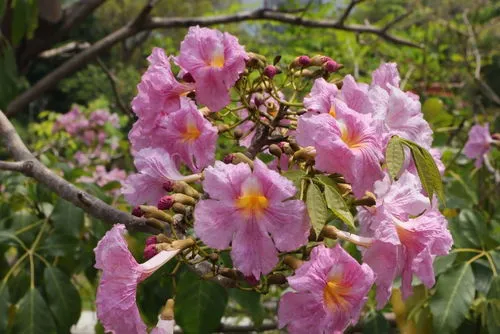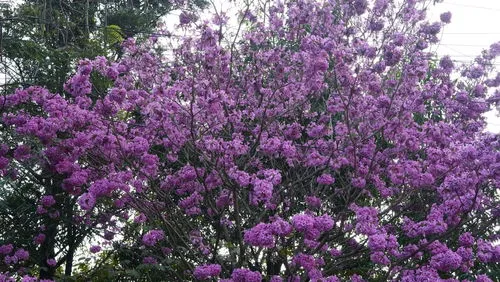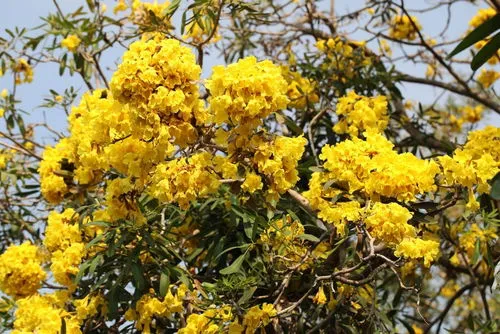All About Tabebuia Rosea: The Stunning Pink Trumpet Tree
Tabebuia Rosea, also known as the Pink Trumpet Tree or Tecoma Pink, is a breathtaking evergreen tree that can add a splash of color to any landscape. With its long, smooth trunk and round, spreading crown, this tree is a sight to behold, especially when it blooms with its stunning trumpet-shaped flowers. Let’s dive into the world of Tabebuia Rosea and explore its characteristics, care, and uses.
Characteristics of Tabebuia Rosea
Appearance
Tabebuia Rosea is known for its beautiful pink and white flowers with yellow throats, which bloom in clusters. The leaves are oblong to ovate-elliptic, leathery, scaly, and mid-to-dark green in color. The flowers first appear after three years of planting, creating a spectacular display.

Growth and Habitat
This tree thrives well in both moist and dry forests, often found in open fields or along roadsides. It is usually planted along roads and in parks and is considered deciduous in climates with a dry season. Interestingly, all the leaves of the Tabebuia Rosea tree fall off during the blooming season, leaving behind clusters of beautiful purple-pink flowers.
National Significance
The rosy trumpet tree is the national tree of El Salvador. When the flowers drop, they create a carpet of flowers on the ground, adding to the tree’s charm.
Botanical Information
Family and Botanical Name
- Family: Bignoniaceae
- Botanical Name: Handroanthus Impetiginosus
Common Names
- Tabebuia Rosea
- Pink Poui
- Rosy Trumpet Tree
- Savannah Oak
- Basant Rani (Hindi)
Native Regions
Tabebuia Rosea is native to Mexico, Central America, Venezuela, and Ecuador.
Sun Exposure and Water Requirements
- Sun Exposure: Full sun
- Water: Moderate water
Size and Flowering Period
- Mature Size: 20 to 40 feet
- Flowering Period: Hot and dry periods, after rain, a few times each year
Soil Type
Tabebuia Rosea prefers fertile soil with good drainage.
Etymology
The genus name is derived from the native Brazilian name, ‘tabebuia’ or ‘taiaveruia’. The species epithet ‘Rosea’ means rose-colored.
Bloom Schedule and Flower Color
- Bloom Schedule: Depends on the climate, usually spring and summer. In India, flowering occurs between January and April.
- Flower Color: Pink. The flowers are trumpet-shaped with five petals, 5-8 cm long, and are large and showy.

Uses of Tabebuia Rosea
Shade and Timber
Tabebuia Rosea is a shade-providing tree with timber used for construction, furniture, cabinet making, interior finish, and boat and cart building.
Traditional Medicine
In traditional medicine, a decoction of the cortex is recommended for anemia and constipation. A decoction of the flowers, leaves, and roots is used to reduce fever and pain, treat tonsil inflammation, and body pain.
Ornamental Value
This tree brings color and vibrancy to any park or garden due to its bright flowers. It is a good roadside tree and suitable for growing in medium to large gardens.

How to Take Care of Tabebuia Rosea
Sunlight
Tabebuia Rosea prefers full sunlight, needing 6-8 hours of direct sunlight a day. It thrives in warm weather.
Soil and Fertilizer
Plants with high drought tolerance prefer fertile soil with good drainage. During the growing period, feed the plant with a balanced liquid fertilizer once every 1-2 months to boost its growth.
Watering
Follow a regular watering schedule that promotes deep root growth. Initially, water the tree twice per week for the first two months. Once the tree has taken root, reduce watering to once a week but increase the volume of water. Seedlings and young plants require frequent, deep watering, especially during the first few months of growth.
Pruning
Pruning dead wood and brittle, old stems is essential for Tabebuia tree care. Prune the plant during dormancy to maintain its shape and size. Remove damaged or dead branches and stems to promote full growth.
Pest and Diseases
The plant is disease and pest-resistant. Use neem oil to deter aphids and mealybugs, miticide for spider mites, and manually remove slugs and snails. However, Tabebuia trees can be affected by the tobacco mosaic virus, which leads to blotching and stunted growth.

Propagation of Tabebuia Rosea
From Seeds
Bees pollinate the flowers, leading to smooth seed pods that yield large numbers of seeds. To propagate with seeds, collect the seeds from the pods after they turn brown and start to crack open. Plant the seeds in pots filled with soil, placing them about half an inch into the soil. Keep the soil moist. Seedlings will appear in four to six weeks. Once the leaves develop, transplant the seedlings outdoors.
From Cuttings
To propagate from a cutting, take 12-14 inches tall cuttings from mature shoots at the start of spring. Strip away the bark around the bottom and dip it in rooting hormone powder. Plant the cutting about an inch into a pot with standard potting soil. Keep the young plant moist as it takes root. It will take about eight weeks for the plant to take root. It can then be transplanted outdoors or into a larger container.

Is Tabebuia Rosea Poisonous?
While Tabebuia Rosea may not be poisonous, it contains a compound known as lapachol, which has toxic side effects. Therefore, its use in cancer drugs is not completely preferred.

Conclusion
Tabebuia Rosea, with its stunning pink flowers and versatile uses, is a valuable addition to any landscape. Whether you’re looking to add a splash of color to your garden or seeking a tree with practical uses, the Pink Trumpet Tree is an excellent choice. With proper care and maintenance, this tree can thrive and bring beauty to your surroundings for years to come.
